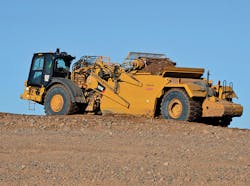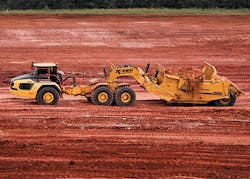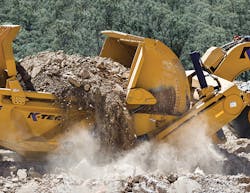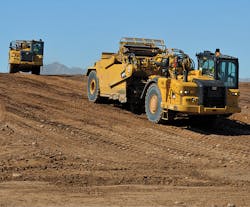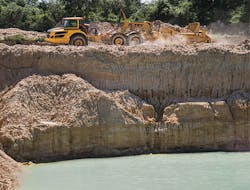Building a concrete road starts with a solid foundation, and graders and scrapers play a key role.
“Large road projects like interstate highway expansions and turnpike corridors are of vital infrastructure importance. Often these projects require millions of cubic yards of material to be moved, with timelines being expedited to under seven months of construction work from start to finish to mitigate traffic constraints and delays,” says Shane Kroeker, spokesperson for K-Tec Earthmovers.
Mark Johnson, product consultant, graders, John Deere, says if an operator is inconsistent in holding the correct grade, the finished gravel may be wavy and transfer up to the finished concrete, putting the road out of spec and possibly requiring grinding or removal.
The first of several layers of building a concrete road often involves cutting massive amounts of material out of high spots to relocate to low spots, says Johnson.
Required equipment may include scrapers, excavators, loaders, dozers, trucks, rollers, and graders.
Once this material has been moved, the bottom layer is put to grade with the motor grader, says Johnson.
In the cut area, scrapers load material and cut the grade down.
“As long as the scrapers don’t overcut or dig too deep, the cut portion is fairly straightforward,” says Scott Bayless, product consultant manager, scraper systems, John Deere.
Scrapers dump the material in the fill area to bring the grade back up.
Consistent lifts of material and compaction are critical in creating a resilient road base, says Bayless.
Drawn scrapers with multiple tires and high weight offer high compaction levels without the need for additional equipment, says Bayless.
As trucks dump the material used for each layer, the material on the ground needs to be processed to get the correct moisture content and placed at the correct location and elevation on the roadbed, notes Johnson.
“The motor grader is very good at this process,” says Johnson. “As the operator rolls material across the moldboard, it helps mix the water into the material. The grader is then used to place the material across the roadbed at the correct depth.”
Rollers are then used to compact the layer. The grader puts the layer to its finished grade, often using GPS for accuracy, says Johnson.
The process continues until the contractor reaches the finished gravel grade and lays concrete, which must be at a precise elevation to tie in with bridge decks and existing roads to ensure sufficient clearance under overpasses, Johnson says.
Eric Kohout, product application specialist, Caterpillar, says achieving tight grade tolerances prevents excessive material use.
“Managing optimum moisture content in the base course material during the finish grading process aids in meeting compaction specifications,” he says. “When the base course meets compaction and finish grade requirements, it allows for an excellent surface to support the concrete road.”
Motor graders help achieve a finished grade surface that delivers the ability to add the next lift while preventing material overruns, Kohout points out.
Cat motor graders offer drawbar, circle, and moldboard (DCM), he says.
The Top Adjust circle helps keep the connection tight from the top of the circle while also supporting moldboard slide rail retention with horizontal and vertical adjustments to assist the operator to keep the DCM tight for an accurate finished product in the least amount of time, he adds.
K-Tec’s Pull-Pan Ejector Scrapers are designed to complete the three functions of earthmoving by picking up, transporting, and smoothly ejecting a load of material, says Kroeker.
The John Deere Scraper System is designed to provide multiple configurations to achieve high levels of compaction in the fill area while reducing the need for excessive haul road maintenance, says Bayless.
John Deere offers scrapers to maximize ground pressure in two-tire configuration or coverage area in four- or six-tire configuration in addition to tractors with single or dual wheels, two tracks or four tracks, for consistent compaction in the fill regardless of material types, says Bayless.
Caterpillar offers standard open bowl and elevating bowl Wheel Tractor-Scrapers (WTS) used to build pads or roadway surfaces by quickly moving multiple material types in different ground conditions, says John Gerhold, Caterpillar product application specialist.
The WTS is designed with a high tire ground pressure rating, considered a benefit in fill locations as the WTS compacts the pad or base as the lifts are being placed to provide a solid base and, in some cases, eliminating the need for additional compaction equipment, says Gerhold.
The standard open bowl machines are optimal for bulk earthmoving, notes Gerhold.
“They are designed to get load very quickly and place the material in the fill,” he adds. “As the project gets closer to grade—depending on the material type of the open bowl—the scraper will be able to leverage Cat Grade Control and put the project on grade,” he says.
The elevating WTS can serve as a prime earthmover on small- to medium-sized projects. It conditions the material as it is removed from the cut, providing material for fill, especially as a project gets close to grade, says Gerhold.
“The standard open and elevating bowl WTS work as a team,” he says. “When the WTS has put the project on grade and the Low Ground Pressure Track-Type Tractor (LGP TTT) or the motor grader is brought in for the blue top, the elevating WTS can be used to pick up any windrows of material to help reduce the amount of material the blue top machine is required to handle.”
In many cases, the WTS will be set up to leave two-tenths of additional material above grade to give the blue top machines material to fill in items like tire prints left by the WTS, says Gerhold.
Material types for an open bowl are sand to ripped material that contains rock less than 24 inches in size; the elevating bowl is limited to work in the sand to the material that contains rock 12 inches or less, says Gerhold.
The standard open bowl is offered in a single- or twin-engine configuration. “The single-engine works well when the project has grades at or less than 8% loaded and 12% empty,” says Gerhold. “The twin-engine configuration offers a wide range of what the standard open bowl can work in.”
The machines can work in very steep grade and soft underfoot applications due to the four-wheel-drive capability, says Gerhold.
Grader specifications depend on job site variables such as size and work scope, which determines the machine’s size, weight, moldboard width, and type of ground engaging tools needed.
Scalable technology solutions drive increased productivity, efficiency, accuracy, and profitability, notes Kahout.
“Operator or fleet preferences determine the motor grader control system needed, joysticks or steering wheel and lever,” he says. “Underfoot conditions, material type, and job site applications determine whether a rear tandem drive machine or an all-wheel-drive machine is needed.”
All-wheel-drive is beneficial for slope work, ditch cutting, and working in sand or wet conditions, says Kahout.
It’s also beneficial for cutting finish grade as the system can engage the creep mode feature to disengage the rear tandems, with the front wheels pulling the machine along at 0 to 5 mph, he adds.
For many years, plus or minus a tenth of a foot was the industry standard, but now there can be just a few millimeters’ tolerance for a new road, says Johnson.
“Many jobs also will have specs as tight as plus or minus 1% on moisture and each layer on the roadbed will have specs for compaction. If the moisture and compaction requirements are not met, the contractor is required to rip that section up and start over,” he says.
Another key aspect of obtaining good compaction is how the lifts of material are placed before compaction, says Bayless.
“If the scraper is not equipped with a grade control system, this height is solely at the operator’s discretion, leaving a lot of room for inconsistencies,” says Bayless.
K-Tec’s earthmoving scrapers are suited for large road-building projects, with high-capacity single scraper models ranging from 28 to 63 cubic yards in a heaped bowl, says Kroeker.
Some of K-Tec’s scrapers can work in train configuration to achieve a tandem heaped capacity of 74 cubic yards behind a single power-unit.
“To speed up cycle times, contractors may use an articulated dump truck to pull the K-Tec scraper to achieve faster haul road speeds of up to 35 mph,” says Kroeker.
The K-Tec Scraper has four large tires spread across the back of the machine designed to help roll over and compact the smoothly-ejected load of material.
The precision finish grade also is a key specification required for roadbuilding projects to ensure slopes and ditches meet standards, says Kroeker.
K-Tec scrapers come Trimble GPS-ready to ensure finish grading applications and bulk earthworks with the scraper are as close as possible to final specifications.
Sequence Assist on the Cat WTS offers the ability to remove 14 individual machines and to implement commands the operators would need to give per cycle, says Gerhold. Load Assist is used as a training tool for inexperienced operators by automatically controlling the cutting depth.
The 3D Cat Grade Control enables the CAT WTS to put the cut and the fill on grade automatically regardless of an operator’s skill level.
“When the final blue top is needed, you know exactly how much material you have left on the pads to fill in tire tracks and can better schedule the time needed for the MG or LGP TTT to put a final grade on,” says Gerhold.
Stable Blade is available on most Cat motor graders to help automatically prevent the machine from bouncing when spreading and grading material.
Auto articulation is a joystick feature designed to reduce operator fatigue and permit faster turns at the end of a machine pass by automatically articulating the machine when the operator enters a steering input to the machine.
The Cat Grade ARO option provides blade mounts, sensor mounting, and wiring harnesses to add a 2D or 3D GNSS and UTS grade system to a Caterpillar MG.
The 2D Cat Grade with a cross slope system enables the operator to set a desired slope and engage the automatic system.
“The operator needs to control only one side of the blade. The other side of the blade will automatically follow, keeping the desired slope,” says Kahout.
The motor grader is used in several different stages to get a road ready for concrete, says Johnson, adding that when dealing with cutting, processing, and placing huge amounts of material, there is the option of using six-wheel-drive with the John Deere motor grader with all six tires pulling as they move the material.
John Deere also has developed a dual-motor circle drive for those required to constantly circle under heavier loads.
The John Deere GP motor grader features an open architecture design to enable the use of Trimble, Topcon, or Leica.
The mastless John Deere SmartGrade Motor Grader provides the accuracy of a Millimeter GPS, says Johnson. It is designed to put the roadbed to grade at the required tight tolerances and apply accuracy to slope and ditch tasks.
John Deere’s Autoload feature enables operators to preset a scraper’s dump height for consistent material lifts and a reduced number of compaction passes for optimum roadbed density, says Bayless.
K-Tec’s ADT Scraper system enables trucks to be utilized for a new purpose with drivers transitioning to an effective scraper operator behind the same wheel, says Kroeker. It features six-wheel drive and K-Tec’s Scraper Automatic Cushion Ride System.
The operator’s eyes can face forward by using the truck’s backup camera that is angle-adjusted towards the cutting edge to view the material flow into the bowl, says Kroeker.
K-Tec’s ergonomic padded armrest and multi-function joystick control are attached to the truck’s operator seat. The cab’s operating system offers a selection of automatic ejector modes for specific soil types and an even spread of the material, optimal for training new operators, says Kroeker. The operating system displays automated load counting productivity and operator service maintenance reminders.
